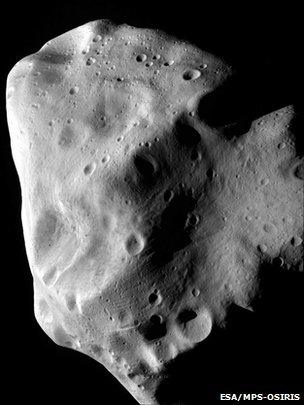Asteroid Lutetia has thick blanket of debris
- Published

About 100km wide, Lutetia is the biggest asteroid yet visited by a spacecraft
Lutetia, the giant asteroid visited by Europe's Rosetta probe in July, is covered in a thick blanket of dusty debris at least 600m (2,000ft) deep.
Aeons of impacts have pulverised the space rock to produce a shattered surface that in terms of texture is much like Earth's Moon, scientists say.
The finding is one of the first to emerge from the wealth of data gathered by Rosetta during its close flyby.
The details are being discussed this week at a conference in Pasadena, US.
Rosetta science team-members will tell the Division for Planetary Sciences (DPS), external of the American Astronomical Society (AAS) that many of their discoveries will need further investigation and discussion before firm conclusions can be drawn.
Rosetta's encounter with the asteroid, external occurred some 454 million km (282 million miles) from Earth, beyond the orbit of Mars.
Multi-wavelength cameras and spectrometers, magnetic field and plasma experiments, dust instruments, a radio science experiment - all were tasked with gathering as much information as possible as the spacecraft whizzed by at the relative speed of 15km/s (9 miles/s) and a minimum distance of 3,162km (1,964 miles).
The data indicates Lutetia has a mass of about 1,700 trillion tonnes.
One calculation for the volume is 650 trillion cubic metres, giving a density of some 3.4 grams per cubic centimetre - not dissimilar to that of Earth's Moon (3.34g per cu cm).
These numbers will play into the debate about Lutetia's true nature - its composition, internal structure and porosity, giving clues to its type.
To date, Earth-based telescopes have had great difficulty in classifying the rock. Some observations had suggested it was a very primitive body, little changed since its formation (a so-called C-type asteroid).
Other measurements, though, had spied what appeared to be metals in its surface, indicating the rock might have undergone a greater degree of evolution (M-type asteroid).
"Only when we've had a good look at the infrared data from Rosetta will we be able to say something about that," said Dr Rita Schulz, from the European Space Agency.
"The spectral information stored in the infrared will give us the minerals. When we clearly have these results then we can say, 'this is Lutetia's type'," Rosetta's project scientist told BBC News.
What is in little doubt from July's spectacular pictures is the beating Lutetia has taken. Impact after impact from other space rocks has ground up the surface to leave a deep regolith, or "soil".
This is immediately evident from the way the outline of some craters is softened, and almost completely obscured in some cases, by overlying debris.

"People have calculated that for an object of this size most of debris ejected from an impact would fall back on to the surface," explained Dr Schulz.
"The escape velocity of a 50km-radius body - that's Lutetia - would be 60m/s. And that would mean 90% of the material trying to get off the asteroid would fall back, and that could explain this blanket."
At closest approach during the flyby, the resolution in Rosetta's pictures was about 60m per pixel, more than sufficient to pick out remarkable details on its surface.
Science team-members are still in the process of counting craters, scarps, pits, ridges, and places where landslides have taken place. Almost 240 boulders of minimum size 100m have been identified.
"Because the asteroid is so big, there is so much to find and we're still doing an inventory," said Dr Schulz.
"For instance, we've now finished putting a grid on the asteroid to give coordinates for every feature."
Rosetta is currently heading further out into the Solar System and is set to rendezvous next with a comet in 2014.
- Published10 July 2010
- Published6 July 2010
- Published28 April 2010